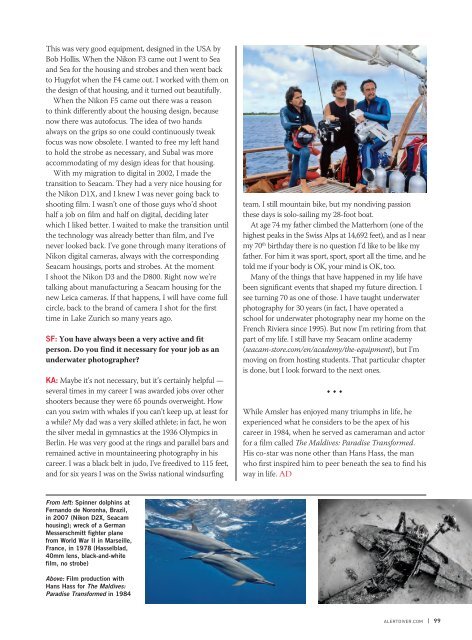AD 2016 Q3
Alert Diver is the dive industry’s leading publication. Featuring DAN’s core content of dive safety, research, education and medical information, each issue is a must-read reference, archived and shared by passionate scuba enthusiasts. In addition, Alert Diver showcases fascinating dive destinations and marine environmental topics through images from the world’s greatest underwater photographers and stories from the most experienced and eloquent dive journalists in the business.
Alert Diver is the dive industry’s leading publication. Featuring DAN’s core content of dive safety, research, education and medical information, each issue is a must-read reference, archived and shared by passionate scuba enthusiasts. In addition, Alert Diver showcases fascinating dive destinations and marine environmental topics through images from the world’s greatest underwater photographers and stories from the most experienced and eloquent dive journalists in the business.
Create successful ePaper yourself
Turn your PDF publications into a flip-book with our unique Google optimized e-Paper software.
This was very good equipment, designed in the USA by<br />
Bob Hollis. When the Nikon F3 came out I went to Sea<br />
and Sea for the housing and strobes and then went back<br />
to Hugyfot when the F4 came out. I worked with them on<br />
the design of that housing, and it turned out beautifully.<br />
When the Nikon F5 came out there was a reason<br />
to think differently about the housing design, because<br />
now there was autofocus. The idea of two hands<br />
always on the grips so one could continuously tweak<br />
focus was now obsolete. I wanted to free my left hand<br />
to hold the strobe as necessary, and Subal was more<br />
accommodating of my design ideas for that housing.<br />
With my migration to digital in 2002, I made the<br />
transition to Seacam. They had a very nice housing for<br />
the Nikon D1X, and I knew I was never going back to<br />
shooting film. I wasn’t one of those guys who’d shoot<br />
half a job on film and half on digital, deciding later<br />
which I liked better. I waited to make the transition until<br />
the technology was already better than film, and I’ve<br />
never looked back. I’ve gone through many iterations of<br />
Nikon digital cameras, always with the corresponding<br />
Seacam housings, ports and strobes. At the moment<br />
I shoot the Nikon D3 and the D800. Right now we’re<br />
talking about manufacturing a Seacam housing for the<br />
new Leica cameras. If that happens, I will have come full<br />
circle, back to the brand of camera I shot for the first<br />
time in Lake Zurich so many years ago.<br />
SF: You have always been a very active and fit<br />
person. Do you find it necessary for your job as an<br />
underwater photographer?<br />
KA: Maybe it’s not necessary, but it’s certainly helpful —<br />
several times in my career I was awarded jobs over other<br />
shooters because they were 65 pounds overweight. How<br />
can you swim with whales if you can’t keep up, at least for<br />
a while? My dad was a very skilled athlete; in fact, he won<br />
the silver medal in gymnastics at the 1936 Olympics in<br />
Berlin. He was very good at the rings and parallel bars and<br />
remained active in mountaineering photography in his<br />
career. I was a black belt in judo, I’ve freedived to 115 feet,<br />
and for six years I was on the Swiss national windsurfing<br />
team. I still mountain bike, but my nondiving passion<br />
these days is solo-sailing my 28-foot boat.<br />
At age 74 my father climbed the Matterhorn (one of the<br />
highest peaks in the Swiss Alps at 14,692 feet), and as I near<br />
my 70 th birthday there is no question I’d like to be like my<br />
father. For him it was sport, sport, sport all the time, and he<br />
told me if your body is OK, your mind is OK, too.<br />
Many of the things that have happened in my life have<br />
been significant events that shaped my future direction. I<br />
see turning 70 as one of those. I have taught underwater<br />
photography for 30 years (in fact, I have operated a<br />
school for underwater photography near my home on the<br />
French Riviera since 1995). But now I’m retiring from that<br />
part of my life. I still have my Seacam online academy<br />
(seacam-store.com/en/academy/the-equipment), but I’m<br />
moving on from hosting students. That particular chapter<br />
is done, but I look forward to the next ones.<br />
•••<br />
While Amsler has enjoyed many triumphs in life, he<br />
experienced what he considers to be the apex of his<br />
career in 1984, when he served as cameraman and actor<br />
for a film called The Maldives: Paradise Transformed.<br />
His co-star was none other than Hans Hass, the man<br />
who first inspired him to peer beneath the sea to find his<br />
way in life. <strong>AD</strong><br />
From left: Spinner dolphins at<br />
Fernando de Noronha, Brazil,<br />
in 2007 (Nikon D2X, Seacam<br />
housing); wreck of a German<br />
Messerschmitt fighter plane<br />
from World War II in Marseille,<br />
France, in 1978 (Hasselblad,<br />
40mm lens, black-and-white<br />
film, no strobe)<br />
Above: Film production with<br />
Hans Hass for The Maldives:<br />
Paradise Transformed in 1984<br />
ALERTDIVER.COM | 99









